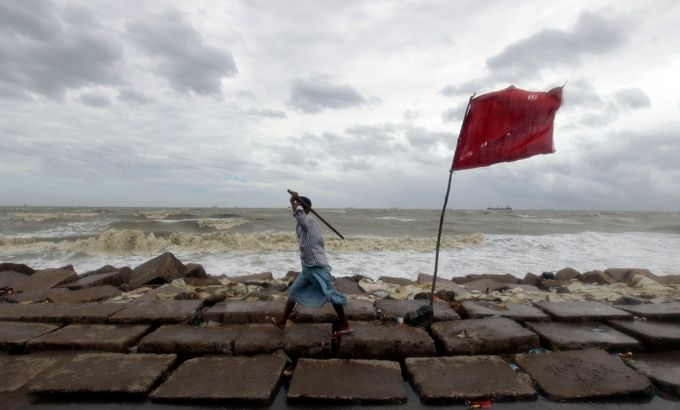Weakening Cyclone Mahasen hits Bangladesh
Thousands evacuated in Bangladesh and Myanmar, with six people reported dead, as storm moves into northeastern India.

Cyclone Mahasen has hit the southern low-lying coast of Bangladesh killing six people, with authorities later downgrading warnings as the storm gradually lost strength.
Myanmar, where there was concern for the safety of many thousands of internally displaced people living in camps, also appeared to have been largely spared.
Keep reading
list of 4 itemsTurtles swimming to extinction in Malaysia as male hatchlings feel heat
Could shipping containers be the answer to Ghana’s housing crisis?
Thousands protest against over-tourism in Spain’s Canary Islands
A storm surge caused some flooding along the coast at high tide, and thousands of rickety huts were destroyed by torrential rain and wind, but the devastation was not as bad as had been feared.
After forcing hundreds thousands of people to evacuate, the storm was moving northeast, into northeastern India, as it lost strength, meteorological officials said.
“It has now crossed over coastal areas and is a land depression over Bangladesh and adjoining areas of India and will gradually weaken further,” Mohammad Shah Alam, the director of the Bangladesh Meteorological Department, told the Reuters news agency.
Earlier, winds of up to 100kph lashed the coast, whipping up big waves as the UN warned that 4.1 million people could be threatened.
Mahasen first hit Khepupara on the southern coast and then weakened as it headed northeast, bringing torrential rain to the ports of Chittagong and Cox’s Bazar.
Witnesses told Reuters that low-lying coastal areas were covered in waist-deep water, trees were uprooted and houses damaged.
A Bangladeshi army official at a control centre set up to help with relief work said six people had been killed, some by falling trees.
Meteorologists said mudslides could still be a danger as heavy rain spreads farther north and east on Thursday night and Friday into easternmost India and northern Myanmar.
Government evacuations
Earlier this week, Bangladesh evacuated more than 700,000 people living in the low-lying areas to thousands of cyclone shelters, while Myanmar announced plans to relocate about 166,000 people on its northwest coast.
Bangladesh, where storms such as Cyclone Nargis in 2008 have killed many people, has more than 1,000 cyclone-proof buildings.
The country had its storm warning at seven, on a scale with a maximum of 10, but later downgraded warnings.
On Tuesday, the storm killed at least seven people and displaced thousands in Sri Lanka as it tracked across the Bay of Bengal towards Bangladesh.
Operations at the local airports in Chittagong and Cox’s Bazar were suspended. Shops were shuttered and roads were empty except for a few cars and rickshaws before the storm hit.
In Myanmar’s state of Rakhine, many Rohingya Muslims made homeless by communal bloodshed last year said they were too scared to move, reflecting their deep mistrust of the authorities and of local Buddhists.
Al Jazeera’s Wayne Hay, reporting from Sittwe, said Myanmar might have escaped the worst but evacuations were continuing and many were seeking refuge in schools, clinics and mosques.
Buddhist-Muslim clashes in the region last year left about 200 people dead and whole neighbourhoods burned to the ground.
The danger faced by those trying to flee was underlined on Monday when 58 Rohingya were left missing after their boat capsized as they tried to escape by sea to higher ground along the coast.
Experts said Bangladesh was better prepared to handle cyclones than authorities across the border in Rakhine, where tens of thousands of Rohingya made homeless by communal unrest last year languished in flood-prone camps.